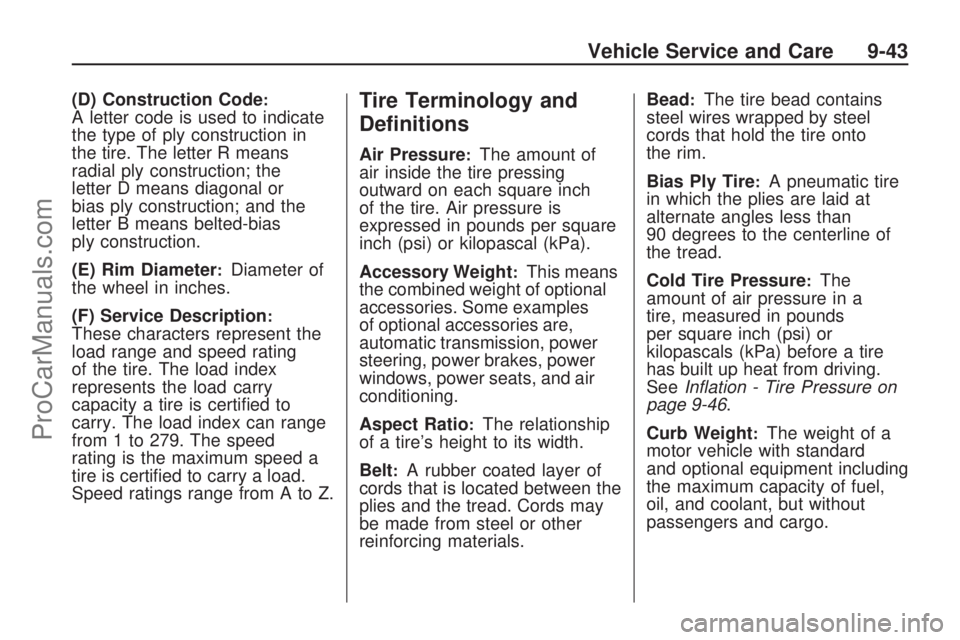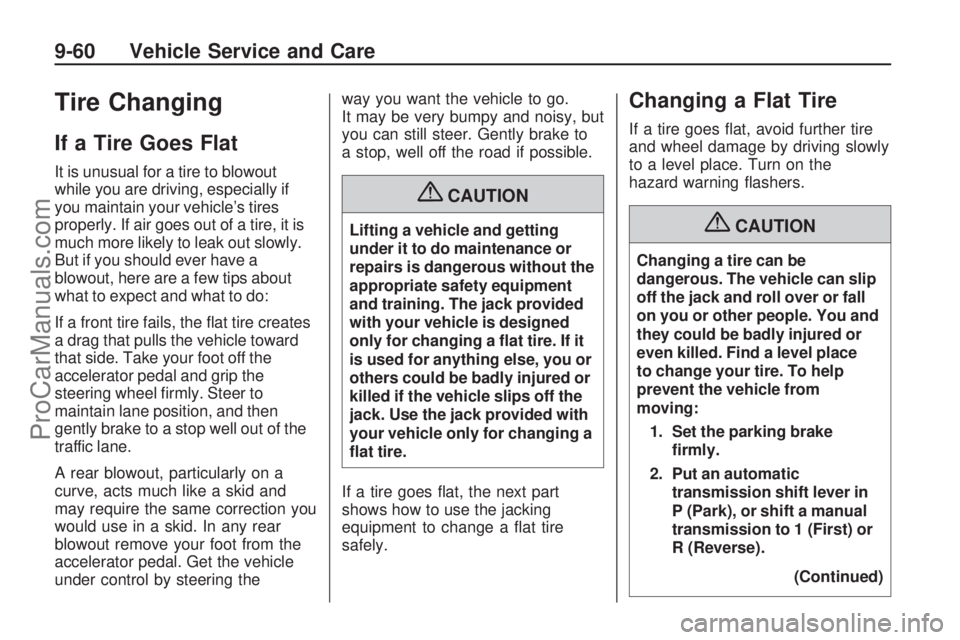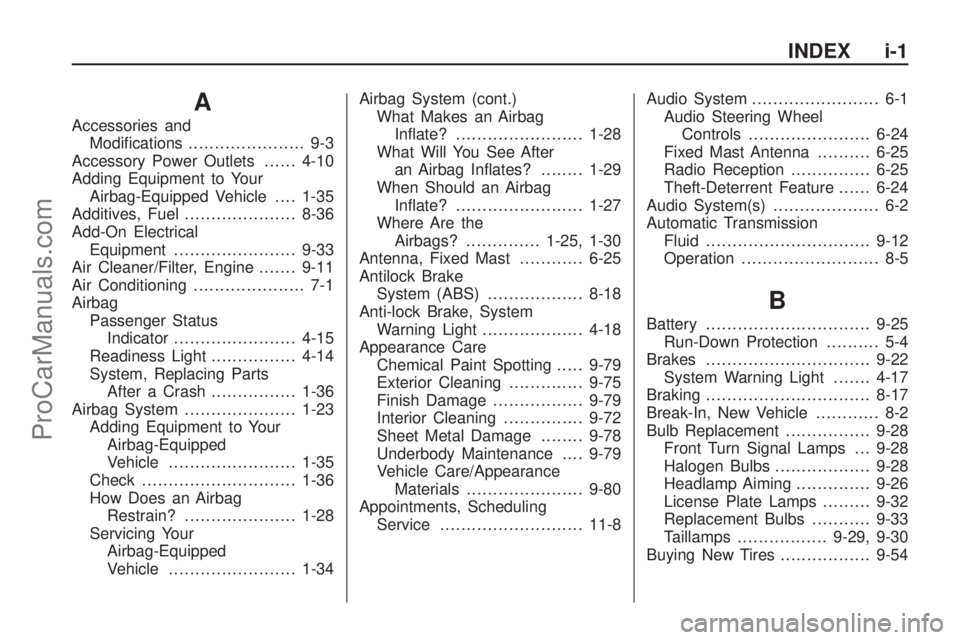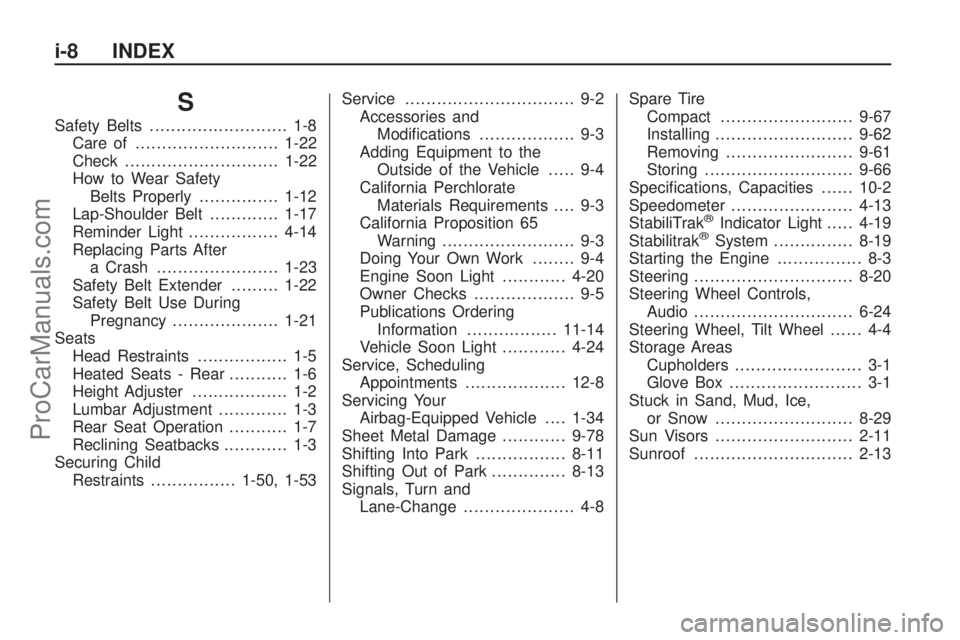steering wheel SATURN ASTRA 2008 Owner's Guide
[x] Cancel search | Manufacturer: SATURN, Model Year: 2008, Model line: ASTRA, Model: SATURN ASTRA 2008Pages: 304, PDF Size: 1.92 MB
Page 233 of 304

(D) Construction Code:A letter code is used to indicate
the type of ply construction in
the tire. The letter R means
radial ply construction; the
letter D means diagonal or
bias ply construction; and the
letter B means belted-bias
ply construction.
(E) Rim Diameter
:Diameter of
the wheel in inches.
(F) Service Description
:These characters represent the
load range and speed rating
of the tire. The load index
represents the load carry
capacity a tire is certi�ed to
carry. The load index can range
from 1 to 279. The speed
rating is the maximum speed a
tire is certi�ed to carry a load.
Speed ratings range from A to Z.
Tire Terminology and
De�nitions
Air Pressure:The amount of
air inside the tire pressing
outward on each square inch
of the tire. Air pressure is
expressed in pounds per square
inch (psi) or kilopascal (kPa).
Accessory Weight
:This means
the combined weight of optional
accessories. Some examples
of optional accessories are,
automatic transmission, power
steering, power brakes, power
windows, power seats, and air
conditioning.
Aspect Ratio
:The relationship
of a tire’s height to its width.
Belt
:A rubber coated layer of
cords that is located between the
plies and the tread. Cords may
be made from steel or other
reinforcing materials.Bead
:The tire bead contains
steel wires wrapped by steel
cords that hold the tire onto
the rim.
Bias Ply Tire
:A pneumatic tire
in which the plies are laid at
alternate angles less than
90 degrees to the centerline of
the tread.
Cold Tire Pressure
:The
amount of air pressure in a
tire, measured in pounds
per square inch (psi) or
kilopascals (kPa) before a tire
has built up heat from driving.
SeeInflation - Tire Pressure on
page 9-46.
Curb Weight
:The weight of a
motor vehicle with standard
and optional equipment including
the maximum capacity of fuel,
oil, and coolant, but without
passengers and cargo.
Vehicle Service and Care 9-43
ProCarManuals.com
Page 250 of 304

Tire Changing
If a Tire Goes Flat
It is unusual for a tire to blowout
while you are driving, especially if
you maintain your vehicle’s tires
properly. If air goes out of a tire, it is
much more likely to leak out slowly.
But if you should ever have a
blowout, here are a few tips about
what to expect and what to do:
If a front tire fails, the �at tire creates
a drag that pulls the vehicle toward
that side. Take your foot off the
accelerator pedal and grip the
steering wheel �rmly. Steer to
maintain lane position, and then
gently brake to a stop well out of the
traffic lane.
A rear blowout, particularly on a
curve, acts much like a skid and
may require the same correction you
would use in a skid. In any rear
blowout remove your foot from the
accelerator pedal. Get the vehicle
under control by steering theway you want the vehicle to go.
It may be very bumpy and noisy, but
you can still steer. Gently brake to
a stop, well off the road if possible.
{CAUTION
Lifting a vehicle and getting
under it to do maintenance or
repairs is dangerous without the
appropriate safety equipment
and training. The jack provided
with your vehicle is designed
only for changing a �at tire. If it
is used for anything else, you or
others could be badly injured or
killed if the vehicle slips off the
jack. Use the jack provided with
your vehicle only for changing a
�at tire.
If a tire goes �at, the next part
shows how to use the jacking
equipment to change a �at tire
safely.
Changing a Flat Tire
If a tire goes �at, avoid further tire
and wheel damage by driving slowly
to a level place. Turn on the
hazard warning �ashers.
{CAUTION
Changing a tire can be
dangerous. The vehicle can slip
off the jack and roll over or fall
on you or other people. You and
they could be badly injured or
even killed. Find a level place
to change your tire. To help
prevent the vehicle from
moving:
1. Set the parking brake
�rmly.
2. Put an automatic
transmission shift lever in
P (Park), or shift a manual
transmission to 1 (First) or
R (Reverse).
(Continued)
9-60 Vehicle Service and Care
ProCarManuals.com
Page 295 of 304

A
Accessories and
Modi�cations...................... 9-3
Accessory Power Outlets......4-10
Adding Equipment to Your
Airbag-Equipped Vehicle....1-35
Additives, Fuel.....................8-36
Add-On Electrical
Equipment.......................9-33
Air Cleaner/Filter, Engine.......9-11
Air Conditioning..................... 7-1
Airbag
Passenger Status
Indicator.......................4-15
Readiness Light................4-14
System, Replacing Parts
After a Crash................1-36
Airbag System.....................1-23
Adding Equipment to Your
Airbag-Equipped
Vehicle........................1-35
Check.............................1-36
How Does an Airbag
Restrain?.....................1-28
Servicing Your
Airbag-Equipped
Vehicle........................1-34Airbag System (cont.)
What Makes an Airbag
In�ate?........................1-28
What Will You See After
an Airbag In�ates?........1-29
When Should an Airbag
In�ate?........................1-27
Where Are the
Airbags?..............1-25, 1-30
Antenna, Fixed Mast............6-25
Antilock Brake
System (ABS)..................8-18
Anti-lock Brake, System
Warning Light...................4-18
Appearance Care
Chemical Paint Spotting.....9-79
Exterior Cleaning..............9-75
Finish Damage.................9-79
Interior Cleaning...............9-72
Sheet Metal Damage........9-78
Underbody Maintenance....9-79
Vehicle Care/Appearance
Materials
......................9-80
Appointments, Scheduling
Service...........................11-8Audio System........................ 6-1
Audio Steering Wheel
Controls.......................6-24
Fixed Mast Antenna..........6-25
Radio Reception...............6-25
Theft-Deterrent Feature......6-24
Audio System(s).................... 6-2
Automatic Transmission
Fluid...............................9-12
Operation.......................... 8-5
B
Battery...............................9-25
Run-Down Protection.......... 5-4
Brakes...............................9-22
System Warning Light.......4-17
Braking...............................8-17
Break-In, New Vehicle............ 8-2
Bulb Replacement................9-28
Front Turn Signal Lamps . . . 9-28
Halogen Bulbs..................9-28
Headlamp Aiming..............9-26
License Plate Lamps.........9-32
Replacement Bulbs...........9-33
Taillamps.................9-29, 9-30
Buying New Tires.................9-54
INDEX i-1
ProCarManuals.com
Page 302 of 304

S
Safety Belts.......................... 1-8
Care of ...........................1-22
Check.............................1-22
How to Wear Safety
Belts Properly...............1-12
Lap-Shoulder Belt.............1-17
Reminder Light.................4-14
Replacing Parts After
a Crash.......................1-23
Safety Belt Extender.........1-22
Safety Belt Use During
Pregnancy....................1-21
Seats
Head Restraints................. 1-5
Heated Seats - Rear........... 1-6
Height Adjuster.................. 1-2
Lumbar Adjustment............. 1-3
Rear Seat Operation........... 1-7
Reclining Seatbacks............ 1-3
Securing Child
Restraints................1-50, 1-53Service................................ 9-2
Accessories and
Modi�cations.................. 9-3
Adding Equipment to the
Outside of the Vehicle..... 9-4
California Perchlorate
Materials Requirements.... 9-3
California Proposition 65
Warning......................... 9-3
Doing Your Own Work........ 9-4
Engine Soon Light............4-20
Owner Checks................... 9-5
Publications Ordering
Information.................11-14
Vehicle Soon Light............4-24
Service, Scheduling
Appointments...................12-8
Servicing Your
Airbag-Equipped Vehicle....1-34
Sheet Metal Damage............9-78
Shifting Into Park.................8-11
Shifting Out of Park..............8-13
Signals, Turn and
Lane-Change..................... 4-8Spare Tire
Compact.........................9-67
Installing..........................9-62
Removing
........................9-61
Storing............................9-66
Speci�cations, Capacities......10-2
Speedometer.......................4-13
StabiliTrak
®Indicator Light.....4-19
Stabilitrak®System...............8-19
Starting the Engine................ 8-3
Steering..............................8-20
Steering Wheel Controls,
Audio..............................6-24
Steering Wheel, Tilt Wheel...... 4-4
Storage Areas
Cupholders........................ 3-1
Glove Box......................... 3-1
Stuck in Sand, Mud, Ice,
or Snow..........................8-29
Sun Visors..........................2-11
Sunroof..............................2-13
i-8 INDEX
ProCarManuals.com